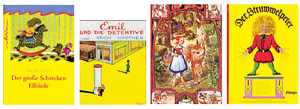Topic 2: Literary Heritage of Germany

Lesson 8: What is the literary heritage for children in Germany?
Lesson Objective
The students will get to know important titles of German children´s literature and compare them to popular American children´s stories.
Materials and Resources

Transparency 13 -
“Literary Heritage”
- Worksheet 11 - “Fairy Tale Interest Survey”
- Teacher Resource 10 - “It's Your Choice”
Introduction
German children learn the name Grimm when they are toddlers. Whether it is in tales told by Grandma: The Wolf And The Seven Young Kids, or when parents tell the story of Little Red Riding Hood, the Brothers Jacob and Wilhelm Grimm are always involved. These two brothers were responsible for investigating all over Germany about fairy tales, passed orally from one generation to the next generation for centuries. They collected the tales in the early 1800s and wrote them down in the form they are still presented to us today. Grimms Hausmärchen (“Brothers Grimm Fairy Tales”) was the first systematic collection of traditional oral folktales reflecting ancient traditional standards, fascinating grown ups as well as children with a certain kind of previous knowledge of good and evil in the world. The collection preserves a rich heritage that has parallelswith other countries and cultures.
Going beyond Grimm’s fairy tales, the works of Heinrich Hoffmann and especially Wilhelm Busch mirror a somewhat higher and thus different belief in morality: Happiness and prosperity are not directed by non-influential tragic situations but depend on one´s own will and behaviour. Busch, as well as Hoffman, show their readers a world in which children who are playing tricks on their next ones are critizised quite severely. Both works are written in an educational and humoristic way: Wilhelm Busch´s Max and Moritz are two little rascals who pull tricks on different people in their village until they get caught. Hardly less popular among children is Heinrich Hoffmann´s Struwwelpeter, another rascal who does not want to have his hair and fingernails cut. In the same short story collection, Paulinchen tempts all warnings and is seduced to play with fire until her dress catches fire and she burns to death. Thus the moral warning is given in a drastic way, somehow exaggerated to bring the message to a dramatic end.
The role of children as objects of a conservative education in the works of the 18th and 19th century certainly changed:
With Erich Kästner – one of the important writers of the 20th century and not only famous for his children’s literature – children as protagonists in literature became more proactive and independent. Their somewhat unconventional behaviour brings about harmony, happiness, unprejudiced thinking into the world of the adults: Lotte and Louise (Das Doppelte Lottchen, “Lisa and Lottie”) reunite their divorced parents in the same way a group of school mates in Das Fliegende Klassenzimmer (“The Flying Class-room”) reunite their beloved teacher with his old friend, whereas Emil and his friends in “Emil und die Detektive” (“Emil and the Detectives”) successfully catch a thief.
A totally anti-authoritarian approach to the understanding of children is reflected in the wonderful story of “Der grosse Schrecken Elfriede”, written in the late 1960s by Otto Jägersberg: Elfriede, an extremely well behaved and conformist little girl one day decides to turn into “the great scare” – and walks with her cat into a “free world” to live on her own.
Strategies
Many students may already be familiar with some of the stories mentioned above. If not, encourage students to read some of Grimm’s fairy tales. Worksheet 11, “Fairy Tale Interest Survey” creates student awareness of the wide variety of topics available in the genre. The survey will also motivate students to make selections for independent reading. For classes familiar with the fairy tales, Teacher Resource 10, “It’s Your Choice” will provoke debate among children. They will have the opportunity to discuss what they value in a friend, and the relative importance of honesty, wealth, and personal integrity.
To discuss the development of children’s literature in Germany show Transparency 13, “Literary Heritage” and ask students – without any prior information - to bring the book titles into a historical order according to the covers in their different style of illustration. Let them explain their reasons and motivate them to find parallels in American children´s literature.

 Printable PDF
Printable PDF